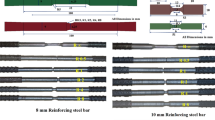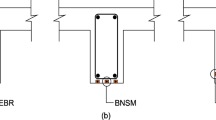Abstract
This study presents the results of a series of creep-recovery experiments that were conducted on asphalt binders modified with polyphosphoric acid (AC+PPA) and Elvaloy® terpolymer combined with polyphosphoric acid (AC+Elvaloy+PPA) at the temperatures of 52, 58, 64, 70 and 76 °C. The multiple stress creep and recovery (MSCR) test was used to determine the percent recoveries (R), the non-recoverable compliances (J nr) and the percent differences in non-recoverable compliances (J nr, diff) of these modified asphalt binders and the ones of the 50/70-penetration grade base material. The base material is graded as PG 64-xx and the formulations with PPA and Elvaloy+PPA are graded as PG 76-xx. Two pairs of loading–unloading times were used in the MSCR tests, namely, 1/9 s and 2/18 s. The AC+Elvaloy+PPA shows not only the highest R values and the lowest J nr values, but also the lowest sensitivity to a sudden increase in the stress level inside the asphalt mixture. Although the results are not as promising as the ones found in the AC+Elvaloy+PPA, the AC+PPA may be taken as an alternative to replace the unmodified asphalt binder when the loading and/or the climate conditions are more severe.





Similar content being viewed by others
Abbreviations
- AASHTO:
-
American Association of state Highway and Transportation Officials
- AC:
-
Asphalt cement or asphalt binder
- ASTM:
-
American Society for Testing and Materials
- DSR:
-
Dynamic shear rheometer
- FHWA:
-
United States Federal Highway Administration
- MSCR:
-
Multiple stress creep and recovery
- PG:
-
Performance grade
- PPA:
-
Polyphosphoric acid
- RCRT:
-
Repeated creep and recovery test
- RTFO:
-
Rolling thin-film oven
- SARA:
-
Saturates, aromatics, resins and asphaltenes
References
Adorjányi K, Füleki P (2011) Performance evaluation of bitumens at high temperature with multiple stress creep recovery test. Hung J Ind Chem 39(2):195–199
Anderson RM (2011) Understanding the MSCR test and its use in the PG asphalt binder specification. Asphalt Academy Webinars, Lexington. http://www.asphaltinstitute.org/dotAsset/48a2c0b0-d756-4b8c-913f-e7aaf91ef03d.pdf. Accessed 25 Jul 2013
Anderson M, D’Angelo J, Walker D (2010) MSCR: a better tool for characterizing high temperature performance properties. Asphalt—The Magazine of the Asphalt Institute, Lexington. http://www.asphaltmagazine.com/news/detail.dot?id=d90e7ce8-f127-4617-ac1d-7d788e2df710. Accessed 28 Jul 2013
Asphalt Institute (2010) Guidance on the use of the MSCR test with the AASHTO M320 specification. Asphalt Institute Technical Advisory Committee, Lexington. http://www.asphaltinstitute.org/dotAsset/9007b936-5596-456f-844b-2fc317700873.pdf. Accessed 28 Jul 2013
Bahia HU, Zhai H, Zeng M, Hu Y, Turner P (2001) Development of binder specification parameters based on characterization of damage behavior. J Assoc Asph Paving Technol 70:442–470
Baumgardner GL (2012) Why and how of polyphosphoric acid modification: an industry perspective. Transp Res Circ E-C160:14–26
Becker Y, Méndez MP, Rodríguez Y (2001) Polymer modified asphalt. Vis Technol 9(1):39–50
Buncher M, D’Angelo J (2012) Establishing a baseline of knowledge through 2005 by reviewing AI IS-220: polyphosphoric acid modification of asphalt. Transp Res Circ E-C160:12–13
D’Angelo JA (2009) The relationship of the MSCR test to rutting. Road Mater Pavement Des 10(Suppl 1):61–80. doi:10.1080/14680629.2009.9690236
D’Angelo J (2010) The multiple stress creep recovery (MSCR) procedure. Federal Highway Administration, Washington. http://www.fhwa.dot.gov/pavement/materials/pubs/hif11038/hif11038.pdf. Accessed 28 Jul 2013
D’Angelo J (2010) New high-temperature binder specification using multistress creep and recovery. Transp Res Circ E-C147:1–13
D’Angelo JA (2012) Effect of polyphosphoric acid on asphalt binder properties. Transp Res Circ E-C160:27–39
D’Angelo J, Dongré R (2009) Practical use of multiple stress creep and recovery test: characterization of styrene–butadiene–styrene dispersion and other additives in polymer-modified asphalt binders. Transp Res Rec 2126:73–82. doi:10.3141/2126-09
D’Angelo J, Kluttz R, Dongré R, Stephens K, Zanzotto L (2007) Revision of the superpave high temperature binder specification: the multiple stress creep recovery test. J Assoc Asph Paving Technol 76:123–162
Delgadillo R, Bahia HU, Lakes R (2012) A nonlinear constitutive relationship for asphalt binders. Mater Struct 45(3):457–473. doi:10.1617/s11527-011-9777-y
Fee D, Maldonado R, Reinke G, Romagosa H (2010) Polyphosphoric acid modification of asphalt. Transp Res Rec 2179:49–57. doi:10.3141/2179-06
Gierhart D (2013) Multiple stress creep recovery (MSCR): why it should be implemented. Louisiana Transportation Conference, Baton Rouge. http://www.ltrc.lsu.edu/ltc_13/pdf/presentations/S43_Why%20the%20Multiple%20Stress%20Creep%20Recovery%20(MSCR)%20Test%20Should%20be%20Implemented_LTC2013.pdf. Accessed 25 Jul 2013
Golalipour A (2011) Modification of multiple stress creep and recovery test procedure and usage in specification. Thesis, University of Wisconsin-Madison, Madison
Huang C-W (2008) Development and numerical implementation of nonlinear viscoelastic–viscoplastic model for asphalt materials. Dissertation, Texas A&M University, College Station
Kalantar ZN, Karim MR, Mahrez A (2012) A review of using waste and virgin polymer in pavement. Constr Build Mater 33:55–62. doi:10.1016/j.conbuildmat.2012.01.009
Masad E, Huang C-W, D’Angelo J, Little D (2009) Characterization of asphalt binder resistance to permanent deformation based on nonlinear viscoelastic analysis of multiple stress creep recovery (MSCR) test. J Assoc Asph Paving Technol 78:535–566
Polacco G, Stastna J, Biondi D, Antonelli F, Vlachovicova Z, Zanzotto L (2004) Rheology of asphalts modified with glycidylmethacrylate functionalized polymers. J Colloid Interface Sci 280(2):366–373. doi:10.1016/j.jcis.2004.08.043
Polacco G, Stastna J, Biondi D, Zanzotto L (2006) Relation between polymer architecture and nonlinear viscoelastic behavior of modified asphalts. Curr Opin Colloid Interface Sci 11(4):230–245. doi:10.1016/j.cocis.2006.09.001
Yildirim Y (2007) Polymer modified asphalt binders. Constr Build Mater 21(1):66–72. doi:10.1016/j.conbuildmat.2005.07.007
Zoorob SE, Castro-Gomes JP, Pereira Oliveira LA, O’Connell J (2012) Investigating the multiple stress creep recovery bitumen characterisation test. Constr Build Mater 30:734–745. doi:10.1016/j.conbuildmat.2011.12.060
Acknowledgments
The first author acknowledges the Brazilian Federal Research Agency (CAPES) for providing a scholarship. The second author gratefully thanks the Research Agency of the Sao Paulo State (FAPESP) for providing financial funds (FAPESP process number 2006/55835-6).
Author information
Authors and Affiliations
Corresponding author
Rights and permissions
About this article
Cite this article
Inocente Domingos, M.D., Faxina, A.L. Rheological analysis of asphalt binders modified with Elvaloy® terpolymer and polyphosphoric acid on the multiple stress creep and recovery test. Mater Struct 48, 1405–1416 (2015). https://doi.org/10.1617/s11527-013-0242-y
Received:
Accepted:
Published:
Issue Date:
DOI: https://doi.org/10.1617/s11527-013-0242-y




